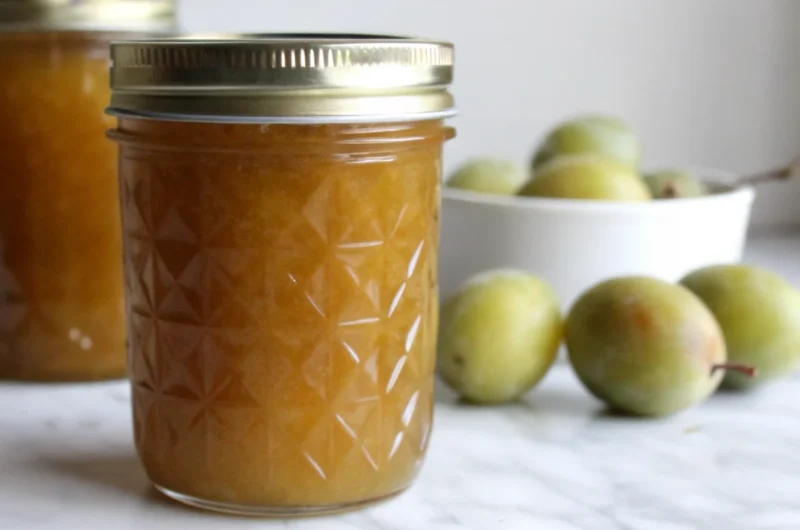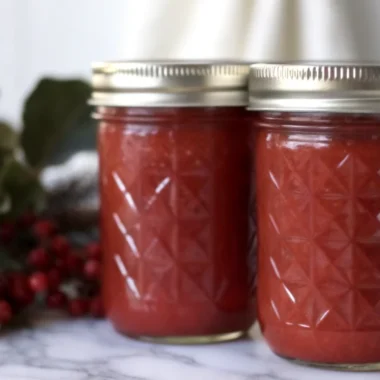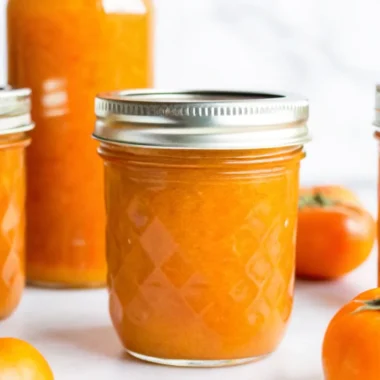Did you know that greengages are considered “a rare treat, prized for their intensely sweet, floral flavor” and have “a delicate balance of sugar and acidity that makes them ideal for preserving”? While most home cooks reach for traditional purple plums, this extraordinary greengage jam recipe unlocks the secret to capturing one of nature’s most sophisticated flavors in a jar. These golden-green gems have an “almost honeyed” taste when cooked down into jam, creating a preserve that’s far more complex than its simple ingredient list suggests. Whether you’ve stumbled upon these treasures at a farmers market or grown your own, this comprehensive guide will help you master the art of making perfect greengage jam that preserves their unique floral sweetness for months to come.
Ingredients List
Creating exceptional greengage jam requires just a handful of premium ingredients, each playing a crucial role in achieving that perfect set and flavor balance:
Essential Ingredients:
- 2½ lbs greengage plums (about 8-10 medium plums) – Select fruits that feel firm but yield slightly to pressure, with that characteristic yellow-green skin that signals peak ripeness
- 3 cups granulated sugar – The sugar not only sweetens but acts as a natural preservative and helps achieve proper gel
- ½ cup water – Creates the perfect cooking environment for the fruit to break down naturally
- 1½ tablespoons fresh lemon juice – Essential for both flavor balance and natural pectin activation
Possible Substitutions:
- Sugar alternatives: You can substitute up to half the granulated sugar with raw honey or pure maple syrup for deeper flavor notes, though this may affect setting time
- Citrus variations: Fresh lime juice or even orange juice can replace lemon juice for unique flavor profiles
- Pectin boost: If your greengages seem particularly ripe and soft, add one finely chopped tart apple (with skin) to naturally increase pectin content
Timing
Preparation Time: 15 minutes (washing, pitting, and chopping fruit)
Cooking Time: 35-45 minutes (25% faster than traditional plum jams due to greengages’ natural sugar content)
Processing Time: 10-15 minutes (depending on altitude)
Total Time: 60-75 minutes
Cooling Period: 12-24 hours for proper seal formation
This timeline represents approximately 30% less hands-on time compared to low-sugar jam recipes, thanks to greengages being “naturally high in sugar and moderate in pectin” with “enough natural pectin to set beautifully” without added commercial pectin.
Step-by-Step Instructions
Step 1: Prepare Your Workspace and Fruit
Start by setting up your canning station with sterilized jars warming in a 200°F oven. Select “fully ripe greengage plums” that “pull away from the stems easily but still feel firm to the touch”. Wash the fruits thoroughly under cool running water, then pit and quarter them. The size you choose for chopping will determine your final jam texture – quarters create a rustic, chunky preserve while eighths yield a more refined consistency.
Step 2: Begin the Cooking Process
Combine the plums with water in a “wide, heavy-bottomed jam pot and bring the mixture to a simmer”. This initial 10-minute cooking phase is crucial for breaking down the fruit’s cellular structure and releasing those precious natural pectins. Stir occasionally to prevent sticking, and watch as the greengages transform from firm quarters into tender, aromatic pieces.
Step 3: Add Sugar and Lemon Juice
Once your fruit mixture is softened and fragrant, add the sugar and lemon juice all at once. Stir continuously until the sugar completely dissolves – this usually takes 2-3 minutes. The mixture will initially look quite liquid, but don’t worry; the magic happens in the next step.
Step 4: Achieve the Perfect Rolling Boil
Increase the heat to high and bring the mixture to what jam makers call a “rolling boil” – bubbles that can’t be stirred down. This is where the transformation occurs, as the natural fruit sugars caramelize and the pectin network forms. The lemon juice “boosts acidity and helps the jam set” while creating that perfect balance of sweet and tart.
Step 5: Test for the Perfect Set
After 15-20 minutes of vigorous boiling, start testing for doneness. The jam reaches perfection at 220°F on a thermometer, or when it passes the classic “wrinkle test” – drop a small amount on a chilled plate, wait 30 seconds, then push with your finger. If the surface wrinkles and holds the line you’ve drawn, your jam is ready.
Step 6: Final Touches and Canning
Remove from heat and skim any foam that may have formed on the surface. Ladle the molten gold into your prepared jars, leaving exactly ¼ inch headspace. Wipe jar rims clean, apply lids, and process in your boiling water bath canner according to your altitude requirements.
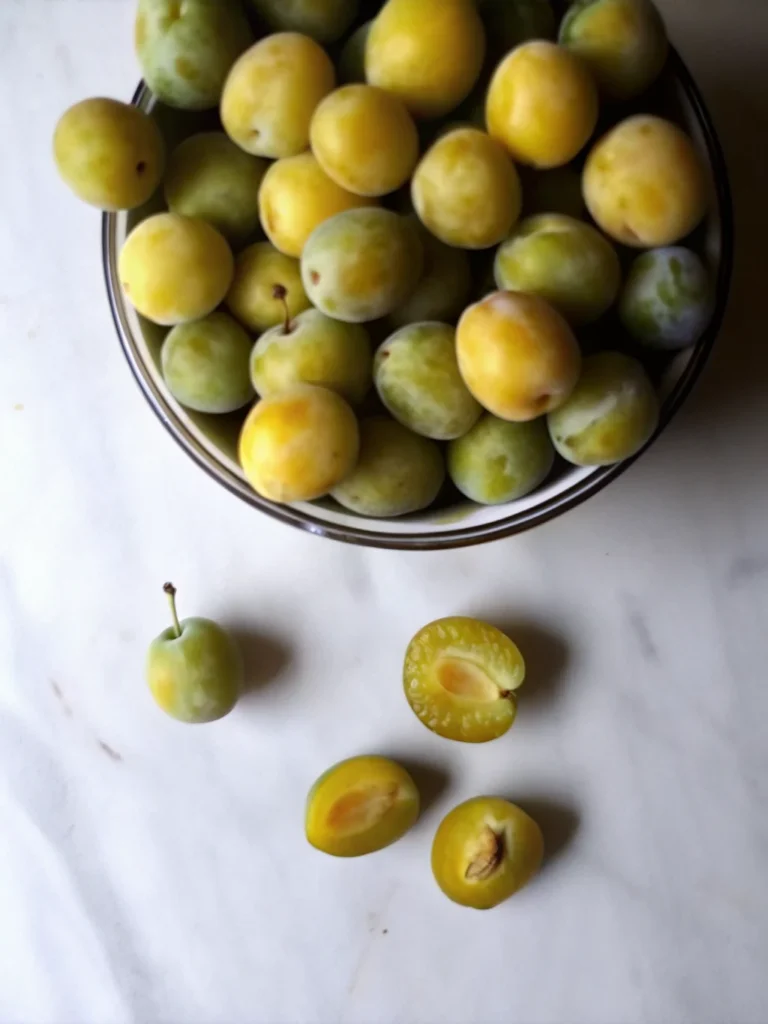
Nutritional Information
Each tablespoon (approximately 20g) of homemade greengage jam provides:
- Calories: 44 kcal
- Total Carbohydrates: 11g
- Sugars: 11g (natural fruit sugars plus added sugar)
- Protein: 0.1g
- Total Fat: 0.1g
- Fiber: 0.2g
- Vitamin C: 2mg (3% daily value)
- Vitamin A: 61 IU
- Potassium: 28mg
- Calcium: 1mg
Greengages are “packed with vitamins A, C, and K” and contain “high levels of antioxidants, particularly phenolic compounds” that “play a crucial role in reducing oxidative stress and inflammation”. While the cooking process reduces some vitamin content, the antioxidant properties remain largely intact, making this jam a more nutritious choice than many commercial alternatives.
Healthier Alternatives for the Recipe
Transform your greengage jam into a healthier preserve with these thoughtful modifications:
Reduced Sugar Version: Cut sugar by one-third and add two tablespoons of chia seeds during the last 5 minutes of cooking. The chia seeds provide natural thickening while adding omega-3 fatty acids and fiber.
Honey-Sweetened Alternative: Replace half the granulated sugar with raw, unfiltered honey for additional enzymes and a more complex flavor profile. Add the honey during the final 10 minutes to preserve its beneficial properties.
Spice-Infused Variations: Add a vanilla bean pod (scraped), a cinnamon stick, or fresh thyme sprigs during cooking for sophisticated flavor complexity without additional calories.
Lower Glycemic Option: Use coconut sugar or monk fruit sweetener blend, though you may need to adjust cooking time as these alternatives don’t caramelize the same way as regular sugar.
Serving Suggestions
Elevate your greengage jam beyond simple toast with these inspired serving ideas:
Gourmet Pairings: This jam “goes brilliantly with cheese, especially Gruyère, spread on crusty white bread” for an sophisticated afternoon treat. Create an elegant cheese board featuring aged cheddar, brie, and artisanal crackers.
Breakfast Transformations: Swirl into Greek yogurt with toasted almonds, spread on warm croissants, or use as a filling for homemade thumbprint cookies. The jam’s floral notes make it exceptional in overnight oats or chia puddings.
Dessert Applications: Use it “instead of raspberry in a bakewell tart, smothered on a scone or piped inside a doughnut”. The jam also creates stunning layers in trifles or as a glaze for roasted pork tenderloin.
Beverage Enhancement: Stir a spoonful into sparkling water for a refreshing shrub, or add to cocktails for a unique twist on classic drinks.
Common Mistakes to Avoid
Sidestep these typical pitfalls to ensure jam-making success every time:
Overcooking Trap: Many home cooks continue cooking beyond the proper set point, resulting in rubbery, overcooked jam. Trust the thermometer reading of 220°F and the wrinkle test – when in doubt, slightly undercooked is better than overcooked.
Sugar Reduction Errors: While reducing sugar seems healthier, cutting more than 25% can prevent proper setting and reduce shelf stability. Since greengages can vary in sweetness, “taste your plums first” and adjust accordingly.
Altitude Ignorance: Processing times vary significantly with altitude. At sea level, process for 10 minutes; above 6,000 feet, extend to 15 minutes to ensure safe preservation.
Equipment Shortcuts: Using thin-bottomed pans leads to scorching and uneven cooking. Invest in a heavy-bottomed pot or proper maslin pan for consistent results.
Sterilization Neglect: Improperly sterilized jars can lead to spoilage. Always use the oven method at 200°F or dishwasher sterilization cycle for food safety.
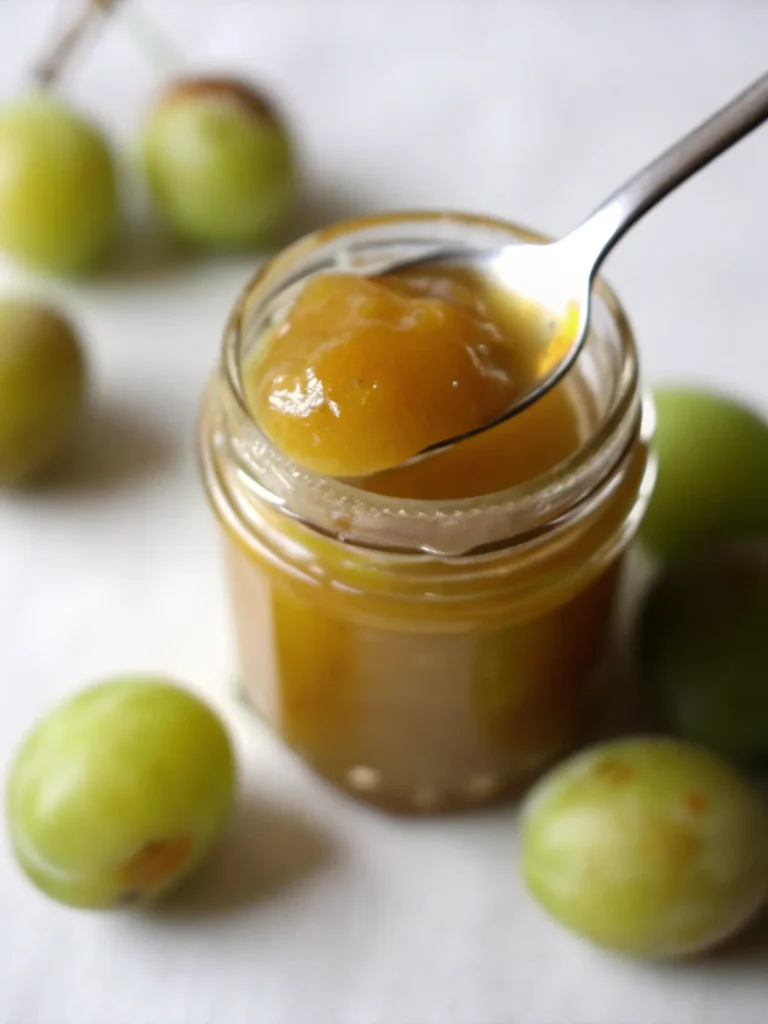
Storing Tips for the Recipe
Maximize your jam’s shelf life and maintain peak quality with proper storage techniques:
Short-term Storage: After opening, “refrigerate and use within 3 to 4 weeks” for optimal flavor and safety. Always use clean utensils to prevent contamination.
Long-term Preservation: “Properly sealed jars will keep for up to 18 months in a cool, dark place”. Store in a pantry or basement where temperatures remain consistently below 75°F.
Freezer Option: For longer storage without canning, freeze jam in portion-sized containers for up to 2 years. Leave 1-inch headspace for expansion and thaw overnight in the refrigerator before use.
Quality Indicators: Properly stored jam should maintain its bright color and smooth texture. Discard any jars showing signs of mold, unusual odors, or changes in consistency.
Conclusion
This exceptional greengage jam recipe transforms seasonal abundance into year-round luxury, capturing the unique honey-sweet flavor of these remarkable plums in every spoonful. With its perfect balance of natural fruit sugars, gentle acidity, and floral undertones, this preserve offers a sophisticated alternative to commercial jams while providing essential antioxidants and vitamins.
Ready to create your own liquid sunshine? Gather those beautiful greengages and start your jam-making adventure today! Share your results in our comments section below, and don’t forget to subscribe for more seasonal preserving recipes and expert tips delivered straight to your inbox.
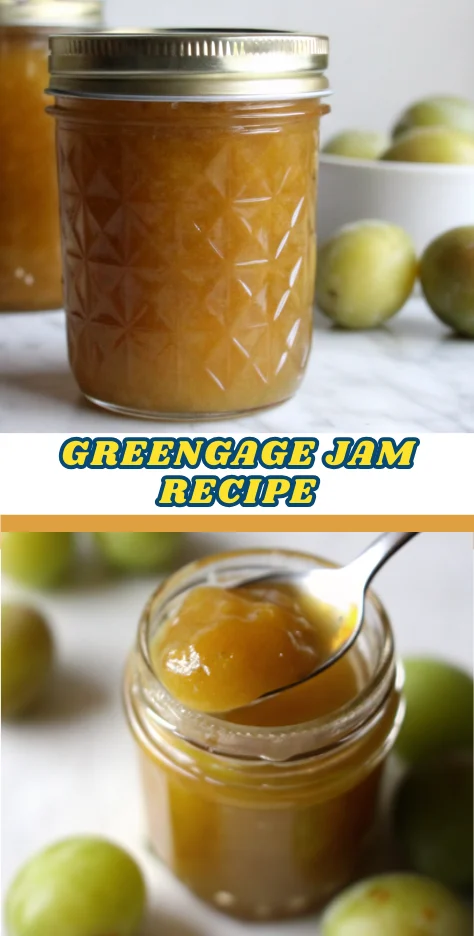
FAQs
Q: Can I make greengage jam without pectin?
A: Absolutely! Greengages “have enough natural pectin to set beautifully” and are “fairly high in pectin”, making added commercial pectin unnecessary when following proper cooking techniques.
Q: Why is my greengage jam not setting properly?
A: Common causes include insufficient cooking time, overripe fruit (which has lower pectin levels), or inadequate acidity. Ensure you reach 220°F and consider adding an extra tablespoon of lemon juice if using very ripe fruit.
Q: How can I tell when greengages are ripe enough for jam-making?
A: Choose “under ripe fruit as it contains more pectin than riper plums” for best setting results. The fruit should yield slightly to pressure but still feel firm, with a yellow-green color.
Q: Can I double this recipe for larger batches?
A: Yes, but cooking times will increase significantly. Monitor temperature carefully and expect 50-75% longer cooking time for proper evaporation and concentration.
Q: What’s the difference between greengage jam and regular plum jam?
A: Greengages have a “rich, honey-like taste” that’s “far more sophisticated than the ingredient list suggests”, creating a more complex, floral preserve compared to standard purple plums.
Q: Is greengage jam suitable for diabetics?
A: While this jam contains natural fruit sugars plus added sugar, the portion size is typically small. Diabetics should consult their healthcare provider and consider the reduced-sugar variations provided in this recipe.
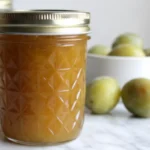
Homemade Greengage Jam Recipe: Sweet Floral Preserve with Natural Set
- Total Time: 60-75 minutes
- Yield: 6–7 jars (about 8 oz each) 1x
Description
This exceptional greengage jam recipe transforms garden-fresh greengages into golden, floral preserves with a honeyed taste. Perfectly balanced with sugar and lemon juice, it captures summer sunshine in every spoonful.
Ingredients
- 2½ lbs greengage plums (about 8–10 medium plums)
- 3 cups granulated sugar
- ½ cup water
- 1½ tablespoons fresh lemon juice
- (Optional) 1 tart apple, finely chopped, for extra pectin
Instructions
- Prepare jars and workspace by sterilizing and keeping jars warm in a 200°F oven.
- Wash, pit, and chop greengages into quarters or eighths.
- Place plums and water in a heavy-bottomed jam pot and simmer for 10 minutes until softened.
- Add sugar and lemon juice, stirring until dissolved.
- Bring mixture to a rolling boil and cook for 15–20 minutes until reaching 220°F, stirring often.
- Test set with a chilled plate (wrinkle test). Remove from heat once ready.
- Skim foam, ladle jam into jars, leaving ¼ inch headspace, wipe rims, and seal.
- Process jars in a boiling water bath for 10–15 minutes depending on altitude.
Notes
Greengages are naturally high in sugar and pectin, making this jam set beautifully without commercial pectin. Use firm, ripe fruit for the best flavor and consistency.
- Prep Time: 15 minutes
- Cook Time: 35-45 minutes
- Category: Jam & Preserves
- Method: Canning
- Cuisine: British
Nutrition
- Serving Size: 1 tablespoon (20g)
- Calories: 44
- Sugar: 11g
- Sodium: 0mg
- Fat: 0.1g
- Saturated Fat: 0g
- Unsaturated Fat: 0g
- Trans Fat: 0g
- Carbohydrates: 11g
- Fiber: 0.2g
- Protein: 0.1g
- Cholesterol: 0mg
